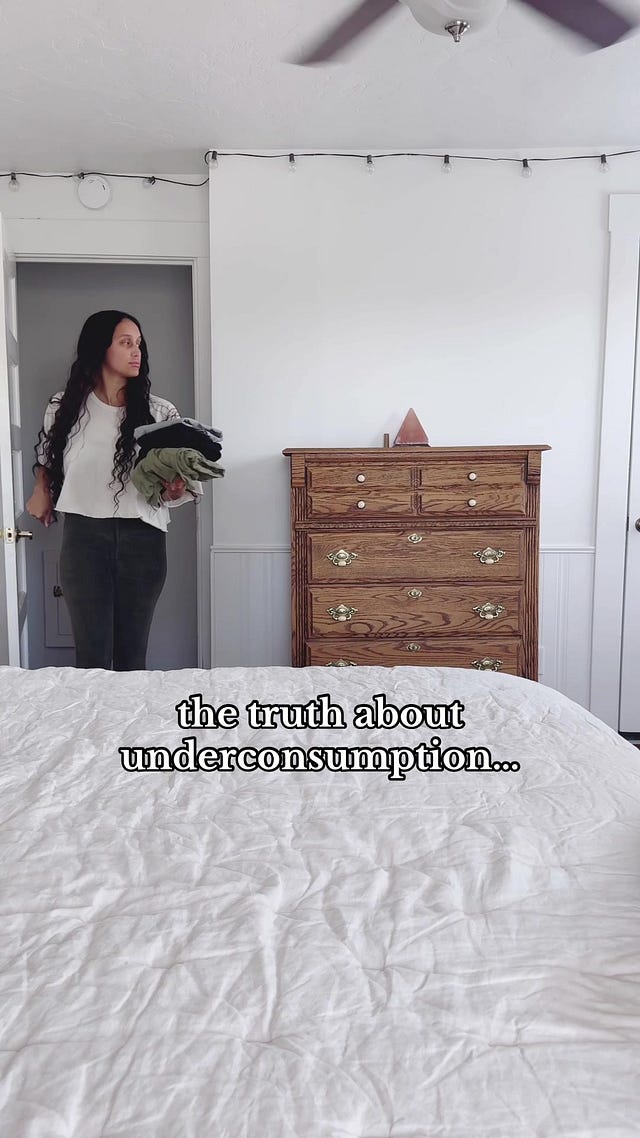The theme of the week is “underconsumption core.” It’s all over my TikTok feed, and likely yours as well. What started as a harmless trend where people showcase the ways they try to buy less (using one product completely before purchasing a new one, driving an older beat-up car that’s completely paid off, only keeping three leggings because they work out three days a week, etc.) has become something quite polarizing. The internet tends to do that.
 Tiktok failed to load.
Tiktok failed to load.Enable 3rd party cookies or use another browser
Some users argued that videos — like the one above — were not, in fact, underconsumption core, but just plain ol’ “normal consumption.” While I understand the point here, I’m not sure I agree — I think it’s pretty radical to slow down your own spending in a society that promotes hauls, dupes, and month-long sales. In fact, I’d argue the concept of overspending and overbuying is what’s normal, not holding off on buying something.
Other users pointed out that it’s a privilege to be able to under-consume. Many people aren’t financially able to participate in hauls, never mind make the active choice to pull back on their spending to save their money. Additionally, while the concept of buying less doesn’t always imply buying better, the fact remains that if you’re able to afford nicer, higher-quality things you’ll likely have to purchase fewer replacements for those items in the future. Some people need to furnish their home with IKEA furniture for financial reasons. Is is their fault then that they can’t “under-consume” because everything they own needs constant replacing?
 Tiktok failed to load.
Tiktok failed to load.Enable 3rd party cookies or use another browser
She says: “Is it my fault that the desk I could afford at one point from Target that’s now wobbling, missing bolts, with chipped laminate veneer over particle board, isn’t made to last? Is it my fault entirely that I will have to replace it? Is it my fault that I didn’t have the time to source the perfect sustainable, in good condition, vintage, non-chipped desk that suits my needs and my space that I could afford?”
Well, is it?!
Which brings me to my point: Why are we pointing fingers at each other when we should be pointing fingers at the companies creating these products. Our “stuff” is getting shittier. I can start by speaking from experience: I have Zara shoes from college that are 10 years old and still holding up. They weren’t expensive or necessarily high-quality, but when wore the appropriate amount, they’ve lasted. The Zara pieces I purchased in the last few years are already fraying. You could make the argument that it’s a fast-fashion brand, it wasn’t made to last. But it did once.
I also did a bit of research (I quickly Google searched) the concept of our products getting worse. A 2023 Vox article by Izzie Ramirez aptly titled “Your Stuff Is Actually Worse Now” digs into why things are produced more poorly now. In the piece, Ramirez says her curiosity was peaked when she tried to repurchase her favorite bra and found the newer version to be totally different despite buying the same design from the same brand. She decided to research if all brands were skimping out on quality. To get to the bottom of the problem, she interviewed experts like Cora Harrington, a writer and lingerie expert, who agreed that clothing quality is getting worse for a number of reasons.
One of the reasons is that consumers are purchasing products faster and companies are, in turn, “incentivized to produce faster and faster and faster.” Our growing greed is part of the reason companies are forced to create cheaper items. Part of me resents this — feels a bit like a chicken or the egg situation, are we greedy or are we being told we always need the latest and greatest — but I can also recognize that I am often baffled when I can’t receive an item in less than week. In this day and age?!
Harrington also speaks to how the climate crisis, the pandemic, and inflation have lead to the increase in the cost of fabric, materials, and labor over the last ten years. She says that since consumers are not privy to the landscape changing, we’re expecting the same products at similar prices when the cost to build and produce these items is no longer the same.
“People don’t exactly want to pay more for all that stuff,” Harrington notes. “So what has to happen if everything is more expensive and the customers still want to pay the same price, something has to be cut and that’s often going to be the quality of the garment.”
The consumer demand for same-day or two-day delivery (see my own complaint above) also seem to lessen the quality because brands are working to churn things out quickly. Hoping on fleeting micro-trends also play a part in this.
Okay, if you’re feeling a bit defensive, like I was, it’s not all on the consumer to promote change.
“The blame does not lie on consumers’ shoulders; corporations are responsible for creating and stoking the “new and more is better” culture we have today.” — Ramirez
Harrington clarifies that companies keep costs low by underpaying and overworking their employees. They utilize cheaper materials, like synthetic fibers, which are made from petroleum and have “propelled the industry to become one of the top carbon polluters in the world.” Ironically, synthetics “fall apart easier, but they don’t entirely decompose as well as natural material.” Lose-lose really.
So where do we go from here? If you are in a position to do so, you can start by shopping smarter. I think the underconsumption trend for the most part is well-intentioned. It is privileged to be able to consume less, but if you can, I think it’s helpful not hurtful to document and encourage others to do the same. You can try to set a goal for the number of pieces you want to buy per year, like I did with my friends. You also, should not feel guilty if you decide to treat yourself. One treat will not make or break the environment. It’s your general apathy towards the problem that will make a difference.
If you do decided to shop, try purchasing second hand or from brands that are focused on being more ethical and sustainable. The Good on You app is a helpful resource, providing ratings on how ethical a brand is based on three factors: its environmental policies, its labor policies, and its animal welfare policies. Not-so-fun fact: When I went to download the app, an ad for the SHEIN app popped up first. 🙃
You can also make it a point to take better care of what you down by following care instructions and getting things mended as they break. Harrington says: “If I visit the tab for fabric composition and there’s nothing there, it’s an instantaneous red flag. You want to know what fibers are in the garments you’re buying.”
For those, who are not in a position to shop from brands that are more sustainable (And usually more costly for the reasons Harrington outlined above), there are actions you can take. You can advocate for regulations and rules surrounding textiles and garments, such as some of the bills currently with Congress or State legislation.
The FABRIC Act, for example, would “encourage transparency in the fashion supply chain, ethical production standards, and a 30% tax credit for clothing producers willing to relocate their manufacturing to the US.” The New York Fashion Act would “require fashion brands to provide detailed reporting on the environmental and social impact of their products. This includes identifying, preventing, and taking remedial measures to address the negative impacts of their corporate actions and that of their supply chain.”
Maybe it’s helpful to note that nothing can be done perfectly, even underconsumption. And perfection is never the point, consistency and betterment is. While we’re arguing with each other about who’s under-consuming correctly, big corporations are profiting. People are being treated unfairly. The environment is being affected. Let’s be kind to each other and more mindful when we can. It’s all we can do.
And now, I leave you with this lighthearted video that made me laugh.
 Tiktok failed to load.
Tiktok failed to load.Enable 3rd party cookies or use another browser









Thanks for introducing the "underconsumption core" and the great article your cited! I also think that “overconsumption” is not always a personal choice—sometimes people have to buy more often because the quality of products is just not there. Really enjoyed the insightful discussion.
Thank you for this informative and intelligent piece on a deceivingly complex topic. I purchased a dress at H&M 15 years ago that is still in perfect condition, and I wear it weekly. I can’t imagine that being possible today.